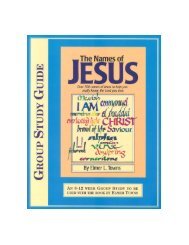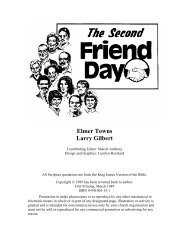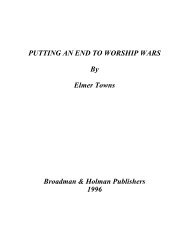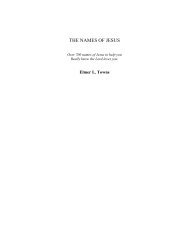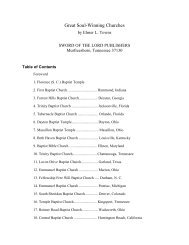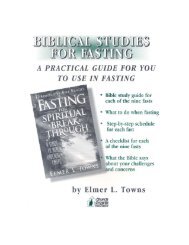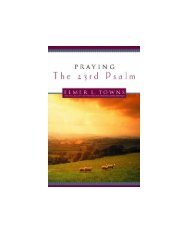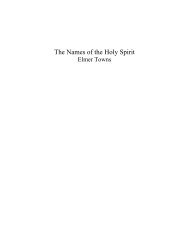A Journey Through The Old Testament - Elmer Towns
A Journey Through The Old Testament - Elmer Towns
A Journey Through The Old Testament - Elmer Towns
Create successful ePaper yourself
Turn your PDF publications into a flip-book with our unique Google optimized e-Paper software.
TWO<br />
ADAM:<br />
<strong>The</strong> Man Who Had Everything to Lose<br />
(Genesis 1:26-3:24)<br />
<strong>The</strong> last day of Creation is the greatest in the sense that God created a person who mirrored Himself.<br />
<strong>The</strong> universe with its awesome power and magnificent beauty did not completely satisfy the Creator. “I will<br />
make man,” determined God. “I will make him like Myself.”<br />
God molded man out of the dirt and as he lay prostrate on the ground, the angels who viewed this<br />
sight could not have imagined the vast potential that could be wrought by this creature who was lower than<br />
them in nature and status. God breathed into this lifeless clay-person and man became a living soul. <strong>The</strong> word<br />
soul means breath; man now had the breath or life of God in him. As man arose from the ground, he reflected<br />
God who made him, for man was made in the image and likeness of God (Gen. 1:26-27).<br />
<strong>The</strong> name Adam is actually a Hebrew word for man and is used in that sense some 560 times in the<br />
<strong>Old</strong> <strong>Testament</strong>. Linguists have suggested his name may mean, “creature,” “ruddy one,” “earthborn,”<br />
“pleasant,” or “social,” but none or certain. <strong>The</strong> word Adam comes from the root for “red,” suggesting red<br />
clay was present when man was created. <strong>The</strong>re seems to be a linguistic relationship between the Hebrew word<br />
for dust and the word for man, which is emphasized in the Creation account (2:7). Adam is identified by his<br />
name eight times in the New <strong>Testament</strong>, plus other references to him where he is not specifically identified.<br />
Someone has suggested the Bible is a story of two men, Adam and Christ, and those who follow<br />
them. This is certainly in keeping with the teaching of the Apostle Paul (Rom. 5:12-21), who identified Christ<br />
as the second Adam.<br />
ADAM, THE SON OF GOD (Gen. 1:26-31; 2:4-25)<br />
<strong>The</strong> only reference to Adam by name in the Gospels concludes the genealogy of Christ, “Adam, the<br />
son of God” (Luke 3:38). This expression reminds the reader that Adam was not born into a family but rather<br />
was created “of God.” <strong>The</strong> <strong>Old</strong> <strong>Testament</strong> uses two words for create to describe the relationship between<br />
Adam and God. <strong>The</strong> first term bara’ emphasizes the power of God in creating Adam (Gen. 1:27). <strong>The</strong> second<br />
term yasar emphasizes His artistic creativity in forming man from the dust much as a potter molds an artistic<br />
vessel of clay (2:7). Adam was the artistic creation of God and what a creation that was!<br />
One of the principles by which God governs His universe is the law “like begets like,” as seen, in the<br />
expression “according to its kind” (Gen. 1:12, 21, 24-25). God created various species of animal and plant life<br />
and they reproduce themselves after their own kind. When God created Adam He continued the same<br />
principle. God highlighted His Creation with a representation or mirror image of Himself (v. 26). In a very real<br />
sense Adam was not just another catalog selection of possible life forms in the mind of God but rather he was a<br />
replica of God Himself. This was Luke’s emphasis when he called Adam “the son of God” (Luke 3:38).<br />
Some Jewish rabbis taught man was created on the sixth day so that God could keep him humble; the<br />
gnat was created before him. <strong>The</strong>re are many reasons for man’s creation on the sixth day, but one suggestion is<br />
that God created the home for man before He created its occupant. One cannot carefully read the description of<br />
Adam’s first home without recognizing the similarity of it with our final home. Adam was created to live and<br />
work in a place that might rightly be called “heaven on earth.” It was a completely self-sufficient environment<br />
with everything Adam could need or want.




